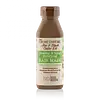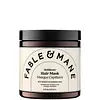What's inside
What's inside
 Key Ingredients
Key Ingredients

 Benefits
Benefits

 Concerns
Concerns

 Ingredients Side-by-side
Ingredients Side-by-side

Water
Skin ConditioningButyrospermum Parkii Butter
Skin ConditioningGlycerin
HumectantBehentrimonium Chloride
PreservativeGlyceryl Stearate
EmollientCetearyl Alcohol
EmollientDicetyldimonium Chloride
EmulsifyingIsopropyl Alcohol
SolventParfum
MaskingAloe Barbadensis Leaf Juice
Skin ConditioningButylene Glycol
HumectantCetyl Alcohol
EmollientCocos Nucifera Oil
MaskingKeratin Amino Acids
Skin ConditioningMenthol
MaskingPanthenol
Skin ConditioningRicinus Communis Seed Oil
MaskingTocopheryl Acetate
AntioxidantBenzophenone-3
UV AbsorberDisodium EDTA
Citronellol
PerfumingHexyl Cinnamal
PerfumingLimonene
PerfumingLinalool
PerfumingBenzyl Alcohol
PerfumingPhenoxyethanol
PreservativeCI 10316
Cosmetic ColorantCI 61570
Cosmetic ColorantCI 16035
Cosmetic ColorantWater, Butyrospermum Parkii Butter, Glycerin, Behentrimonium Chloride, Glyceryl Stearate, Cetearyl Alcohol, Dicetyldimonium Chloride, Isopropyl Alcohol, Parfum, Aloe Barbadensis Leaf Juice, Butylene Glycol, Cetyl Alcohol, Cocos Nucifera Oil, Keratin Amino Acids, Menthol, Panthenol, Ricinus Communis Seed Oil, Tocopheryl Acetate, Benzophenone-3, Disodium EDTA, Citronellol, Hexyl Cinnamal, Limonene, Linalool, Benzyl Alcohol, Phenoxyethanol, CI 10316, CI 61570, CI 16035
Water
Skin ConditioningAloe Barbadensis Leaf Juice
Skin ConditioningBehentrimonium Chloride
PreservativeGlycerin
HumectantLimnanthes Alba Seed Oil
Skin ConditioningCetearyl Alcohol
EmollientTheobroma Cacao Seed Butter
EmollientButyrospermum Parkii Butter
Skin ConditioningParfum
MaskingGlyceryl Stearate
EmollientCetyl Alcohol
EmollientTocopherol
AntioxidantTocopheryl Acetate
AntioxidantBacopa Monnieri Extract
Skin ConditioningEclipta Prostrata Extract
Skin ConditioningCitrus Aurantium Dulcis Fruit Extract
MaskingCitrus Limon Fruit Extract
MaskingCurcuma Longa Root Extract
MaskingMusa Sapientum Fruit Extract
Skin ConditioningWithania Somnifera Root Extract
Skin ConditioningEmblica Officinalis Fruit Extract
Skin ConditioningAcer Saccharum Extract
Skin ConditioningHibiscus Sabdariffa Flower Extract
Skin ConditioningGmelina Arborea Root Extract
Skin ConditioningOroxylum Indicum Root Extract
Skin ConditioningPremna Serratifolia Root Extract
Skin ConditioningSolanum Indicum Root Extract
Skin ConditioningSolanum Xanthocarpum Root Extract
MaskingStereospermum Suaveolens Root Extract
Skin ConditioningTribulus Terrestris Root Extract
Skin ConditioningSaccharum Officinarum Extract
MoisturisingTrigonella Foenum-Graecum Seed Extract
PerfumingVaccinium Myrtillus Fruit Extract
Skin ConditioningPueraria Lobata Root Extract
HumectantLinum Usitatissimum Seed Oil
PerfumingSesamum Indicum Seed Oil
EmollientMelia Azadirachta Seed Oil
EmollientHelianthus Annuus Seed Oil
EmollientCarthamus Tinctorius Seed Oil
MaskingBrassica Campestris Seed Oil
Skin ConditioningOrbignya Speciosa Kernel Oil
EmollientAstrocaryum Murumuru Seed Butter
EmollientMangifera Indica Seed Butter
Skin ConditioningCocos Nucifera Fruit Water
Skin ConditioningHydroxyethylcellulose
Emulsion StabilisingGuar Hydroxypropyltrimonium Chloride
Skin ConditioningSodium Stearoyl Lactylate
EmulsifyingEthylhexylglycerin
Skin ConditioningPolyquaternium-10
Citric Acid
BufferingIsopropyl Alcohol
SolventPotassium Sorbate
PreservativePhenoxyethanol
PreservativeCoumarin
PerfumingCitronellol
PerfumingWater, Aloe Barbadensis Leaf Juice, Behentrimonium Chloride, Glycerin, Limnanthes Alba Seed Oil, Cetearyl Alcohol, Theobroma Cacao Seed Butter, Butyrospermum Parkii Butter, Parfum, Glyceryl Stearate, Cetyl Alcohol, Tocopherol, Tocopheryl Acetate, Bacopa Monnieri Extract, Eclipta Prostrata Extract, Citrus Aurantium Dulcis Fruit Extract, Citrus Limon Fruit Extract, Curcuma Longa Root Extract, Musa Sapientum Fruit Extract, Withania Somnifera Root Extract, Emblica Officinalis Fruit Extract, Acer Saccharum Extract, Hibiscus Sabdariffa Flower Extract, Gmelina Arborea Root Extract, Oroxylum Indicum Root Extract, Premna Serratifolia Root Extract, Solanum Indicum Root Extract, Solanum Xanthocarpum Root Extract, Stereospermum Suaveolens Root Extract, Tribulus Terrestris Root Extract, Saccharum Officinarum Extract, Trigonella Foenum-Graecum Seed Extract, Vaccinium Myrtillus Fruit Extract, Pueraria Lobata Root Extract, Linum Usitatissimum Seed Oil, Sesamum Indicum Seed Oil, Melia Azadirachta Seed Oil, Helianthus Annuus Seed Oil, Carthamus Tinctorius Seed Oil, Brassica Campestris Seed Oil, Orbignya Speciosa Kernel Oil, Astrocaryum Murumuru Seed Butter, Mangifera Indica Seed Butter, Cocos Nucifera Fruit Water, Hydroxyethylcellulose, Guar Hydroxypropyltrimonium Chloride, Sodium Stearoyl Lactylate, Ethylhexylglycerin, Polyquaternium-10, Citric Acid, Isopropyl Alcohol, Potassium Sorbate, Phenoxyethanol, Coumarin, Citronellol
Ingredients Explained
These ingredients are found in both products.
Ingredients higher up in an ingredient list are typically present in a larger amount.
Aloe Barbadensis Leaf Juice comes from leaves of the aloe plant. Aloe Barbadensis Leaf Juice is best known for helping to soothe sunburns. It is also anti-inflammatory, moisturizing, antiseptic, and can help heal wounds.
Aloe is packed with good stuff including Vitamins A, C, and E. These vitamins are antioxidants, which help fight free-radicals and the damage they may cause. Free-radicals are molecules that may damage your skin cells, such as pollution.
Aloe Barbadensis Leaf Juice also contains sugars. These sugars come in the form of monosaccharides and polysaccharides, folic acid, and choline. These sugars are able to help bind moisture to skin.
It also contains minerals such as calcium, 12 anthraquinones, fatty acids, amino acids, and Vitamin B12.
Learn more about Aloe Barbadensis Leaf JuiceThis ingredient is a preservative and often used for it's anti-static properties. You'll most likely see this ingredient in hair conditioners.
It does not cause irritation or sensitization in leave-on products at 1-5%.
This ingredient is also known as shea butter. It is an effective skin hydrator and emollient.
Emollients help soothe and soften your skin. It does this by creating a protective film on your skin. This barrier helps trap moisture and keeps your skin hydrated. Emollients may be effective at treating dry or itchy skin.
Shea butter is rich in antioxidants. Antioxidants help fight free-radicals, or molecules that may harm the body. It is also full of fatty acids including stearic acid and linoleic acid. These acids help replenish the skin and keep skin moisturized.
While Shea Butter has an SPF rating of about 3-4, it is not a sunscreen replacement.
Shea butter may not be fungal acne safe. We recommend speaking with a professional if you have any concerns.
Learn more about Butyrospermum Parkii ButterCetearyl alcohol is a mixture of two fatty alcohols: cetyl alcohol and stearyl alcohol. It is mainly used as an emulsifier. Emulsifiers help prevent the separation of oils and products. Due to its composition, it can also be used to thicken a product or help create foam.
Cetearyl alcohol is an emollient. Emollients help soothe and hydrate the skin by trapping moisture.
Studies show Cetearyl alcohol is non-toxic and non-irritating. The FDA allows products labeled "alcohol-free" to have fatty alcohols.
This ingredient is usually derived from plant oils such as palm, vegetable, or coconut oils. There is debate on whether this ingredient will cause acne.
Due to the fatty acid base, this ingredient may not be Malassezia folliculitis safe.
Learn more about Cetearyl AlcoholCetyl Alcohol is a fatty alcohol. Fatty Alcohols are most often used as an emollient or to thicken a product.
Its main roles are:
Though it has "alcohol" in the name, it is not related to denatured alcohol or ethyl alcohol.
The FDA allows products labeled "alcohol-free" to have fatty alcohols.
Learn more about Cetyl AlcoholCitronellol is used to add fragrance/parfum to a product. It is often derived from plants such as roses. In fact, it can be found in many essential oils including geranium, lavender, neroli, and more. The scent of Citronellol is often described as "fresh, grassy, and citrus-like".
Since the Citronellol molecule is already unstable, Citronellol becomes irritating on the skin when exposed to air.
Citronellol is a modified terpene. Terpenes are unsaturated hydrocarbons found in plants. They make up the primary part of essential oils.
Citronellol is not able to be absorbed into deeper layers of the skin. It has low permeability,
Citronellol is also a natural insect repellent.
Learn more about CitronellolGlycerin is already naturally found in your skin. It helps moisturize and protect your skin.
A study from 2016 found glycerin to be more effective as a humectant than AHAs and hyaluronic acid.
As a humectant, it helps the skin stay hydrated by pulling moisture to your skin. The low molecular weight of glycerin allows it to pull moisture into the deeper layers of your skin.
Hydrated skin improves your skin barrier; Your skin barrier helps protect against irritants and bacteria.
Glycerin has also been found to have antimicrobial and antiviral properties. Due to these properties, glycerin is often used in wound and burn treatments.
In cosmetics, glycerin is usually derived from plants such as soybean or palm. However, it can also be sourced from animals, such as tallow or animal fat.
This ingredient is organic, colorless, odorless, and non-toxic.
Glycerin is the name for this ingredient in American English. British English uses Glycerol/Glycerine.
Learn more about GlycerinGlyceryl Stearate is a mix of glycerin and stearic acid.
It is used to stabilize the mixing of water and oil ingredients. By preventing these ingredients from separating, it can help elongate shelf life. It can also help thicken the product's texture.
As an emollient, it helps soften skin and supports barrier-replenishing ingredients.
In cosmetics, Glyceryl Stearate is often made from vegetable oils or synthetically produced.
This ingredient may not be fungal-acne safe
Fun fact: The human body also creates Glyceryl Stearate naturally.
Learn more about Glyceryl StearateIsopropyl Alcohol is more commonly known as rubbing alcohol. It is most commonly used as a solvent, meaning it helps other ingredients dissolve.
This ingredient is an astringent alcohol. Astringent alcohols may also irritate skin as they high amounts may strip away your skin's natural oils.
Other types of astringent alcohols include:
According to the National Rosacea Society based in the US, you should be mindful of products with these alcohols in the top half of ingredients.
Any type of sanitizing product will have high amounts of alcohol to help kill bacteria and viruses.
Learn more about Isopropyl AlcoholParfum is a catch-all term for an ingredient or more that is used to give a scent to products.
Also called "fragrance", this ingredient can be a blend of hundreds of chemicals or plant oils. This means every product with "fragrance" or "parfum" in the ingredients list is a different mixture.
For instance, Habanolide is a proprietary trade name for a specific aroma chemical. When used as a fragrance ingredient in cosmetics, most aroma chemicals fall under the broad labeling category of “FRAGRANCE” or “PARFUM” according to EU and US regulations.
The term 'parfum' or 'fragrance' is not regulated in many countries. In many cases, it is up to the brand to define this term.
For instance, many brands choose to label themselves as "fragrance-free" because they are not using synthetic fragrances. However, their products may still contain ingredients such as essential oils that are considered a fragrance by INCI standards.
One example is Calendula flower extract. Calendula is an essential oil that still imparts a scent or 'fragrance'.
Depending on the blend, the ingredients in the mixture can cause allergies and sensitivities on the skin. Some ingredients that are known EU allergens include linalool and citronellol.
Parfum can also be used to mask or cover an unpleasant scent.
The bottom line is: not all fragrances/parfum/ingredients are created equally. If you are worried about fragrances, we recommend taking a closer look at an ingredient. And of course, we always recommend speaking with a professional.
Learn more about ParfumPhenoxyethanol is a preservative that has germicide, antimicrobial, and aromatic properties. Studies show that phenoxyethanol can prevent microbial growth. By itself, it has a scent that is similar to that of a rose.
It's often used in formulations along with Caprylyl Glycol to preserve the shelf life of products.
Tocopheryl Acetate is AKA Vitamin E. It is an antioxidant and protects your skin from free radicals. Free radicals damage the skin by breaking down collagen.
One study found using Tocopheryl Acetate with Vitamin C decreased the number of sunburned cells.
Tocopheryl Acetate is commonly found in both skincare and dietary supplements.
Learn more about Tocopheryl AcetateWater. It's the most common cosmetic ingredient of all. You'll usually see it at the top of ingredient lists, meaning that it makes up the largest part of the product.
So why is it so popular? Water most often acts as a solvent - this means that it helps dissolve other ingredients into the formulation.
You'll also recognize water as that liquid we all need to stay alive. If you see this, drink a glass of water. Stay hydrated!
Learn more about Water